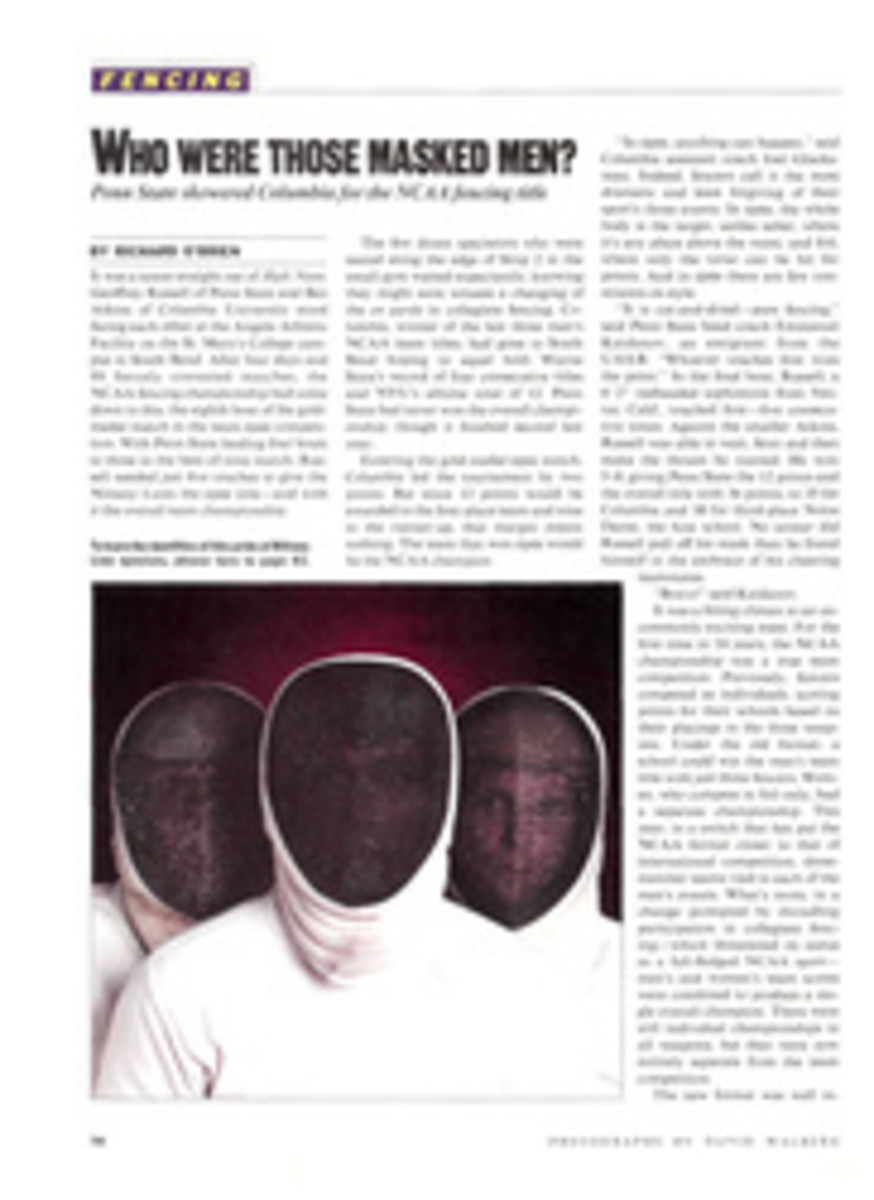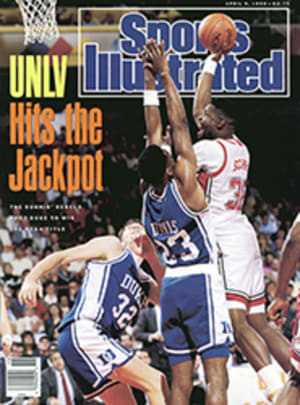
KEEPING COOL UNDER FIRE
Above the resonant crack of the small-bore gunfire, and over the metallic pop of the air rifles not far away, you could not hear the young men muttering. But you could read the words coming from their lips, and see at times the fleeting anguish on their faces—the reflexive twinges of pain, the wide-eyed disbelief, the eyes closing and the heads dropping at the sudden betrayal of nerve.
Tony Hammett had seen all this for years, of course, long before the National Collegiate Athletic Association rifle championships, on March 9-10 at the U.S. Naval Academy in Annapolis, Md., but he seemed to relish making his point again, mischievously twirling one end of his handlebar mustache as he scanned the range for young men who were obviously losing their grip. "Believe me, when they're at the line, you can see the difference between the men and women shooters right away," said Hammett, the rifle coach for Texas at El Paso. "You can't tell when a woman makes a bad shot; her facial expression never changes. The men make a bad shot, they jerk the bolt back, or they hit their weapon with the palm of their hands. They don't handle it near as well. Just watch."
Watch struggling Matt Suggs. The 21-year-old senior from the University of South Florida had arrived at the NCAAs as the top seed in the individual smallbore (.22-caliber) championship. But in less than half an hour he had begun digging himself into a hole so considerable that he nearly disappeared altogether. (He was only seven points behind the leader, who happened to be his twin brother, Will, of the Naval Academy, but in shooting, that gap can mean the difference between first and seventh place.) At one point, lying belly down, Suggs took slow and methodical aim at the bull's-eye 50 feet away, a pinpoint even smaller than the period at the end of this sentence. Suggs fired wide of the mark, scoring nine out of a possible 10, but was so annoyed at missing the eye that he slapped himself hard on the side of the head.
When Xavier University's team captain, Matthew Bykowski, missed the target he was shooting at, he angrily snapped open his rifle bolt and stood shaking his head in disgust, kicking at the ground. Hammett watched this performance, laughed and said, "See that? See him get mad and jerk that bolt open? You wouldn't see a woman doing something like that."
Which is the main reason why Hammett, after years spent teaching shooting, believes that women are cooler and more capable performers than men are. "They are better, definitely, because they are mentally better suited for it," he says.
Riflery is the only NCAA sport in which women and men compete against each other in the same events. Last year, for the first time, women won both the individual smallbore and air rifle competitions at the NCAAs, and surely there is some reason why females outgunned the men overall again this year. West Virginia's Gary Hardy did end up winning the air rifle, making 40 shots with more consistency over four rounds than any other athlete. But five of the first eight finishers in the event were women, including second-place Deena Wigger of Murray State, the 1988 NCAA air rifle champion, and Texas at El Paso's fourth-place Soma Dutta, who got into the shooting sports when she decided, at age seven, that she wanted to hunt tigers in her native India.
A two-time Olympian for India, Dutta, one of a small but growing number of female sharpshooters in the U.S., finally settled instead for shooting ranges in Texas. Of the 31 competitors for the smallbore title, the more coveted of the two individual championships, there were only six women, but three of them finished in the top five. South Florida's Michelle Scarborough defeated West Virginia senior Tammie DeAngelis by the slimmest of margins, 1,165-1,164, and Dutta finished fifth.
Scarborough, a South Dakota transplant, won last year's air rifle title, with a record score of 399—she missed only one bull's-eye in 40 shots from a distance of 10 meters.
DeAngelis was everywhere. In team competition on the second day, she was one of three women involved in the Mountaineers' four-person team victory in the air rifle competition, and she was also the lone female on the West Virginia winning smallbore team. Of course, West Virginia easily won its third straight NCAA rifle title along the way. Teams aside, it was Wigger who performed most brilliantly on the second day, when she ran up a total of 1,177 points, easily the best performance of the weekend in smallbore. Nearly single-handedly, she took Murray State to a fourth-place tie among the eight schools competing in smallbore.
Of the three shooting positions in the two rifle events—prone, standing and kneeling in smallbore; standing only in the air rifle—prone is considered the easiest and standing the most difficult. The four top women shooters—Wigger, DeAngelis, Scarborough and Dutta—prefer to stand. But that's not so surprising. Women generally have shorter torsos and wider hips than men, and such a build allows a woman, as she sights the target, to rest the elbow of the forward arm on the hip. "Men rest the elbow on their rib cage," says Paul Benneche, the University of Virginia's rifle coach.
"I don't like prone, lying on your belly and putting your chin up all the time," says Dutta. "Kneeling is the most awkward. Your knees start hurting and, worse, they fall asleep. Standing is the most natural."
Their physical structure notwithstanding, women derive a greater advantage, Benneche believes, from the fact that unlike men, they usually come to the sport uncorrupted by macho war games, such as cops and robbers. "Women have no preconceived notions of how good they can or should be," says Benneche. "They did not play cowboys and Indians. They have no thoughts of being expert marksmen. There are no macho needs. Men have played war games. They've been hunters. They are too emotionally involved. Women go about learning in a scientific fashion."
And at the line, the top women have the detached, businesslike demeanor of SWAT team members. "We're not as jumpy as men," says Dutta. "They jump and swear and throw their rifles. You can't do that and shoot well."
Rifle shooting requires intense mental stamina and utter precision. In smallbore alone, shooters have 180 minutes in which to take 120 shots at the three positions, not including 15-minute breaks when they change positions and three-minute timeouts when targets are replaced. The time is strictly allotted: Shooters have one minute per shot prone, two minutes per shot standing and 90 seconds per shot kneeling. The hours of competition are long and lonely. "You're talking an extreme level of concentration over a period of up to five hours." says Matt Suggs. "I feel the same after shooting a match as I do after taking an engineering exam. It leaves you drained."
Hammett says that men still feel hacked when a woman beats them in a match. "The hardest thing for a man to accept is getting his feathers trimmed by a woman," he says. "I've seen it on my own team. If they say anything different than that, they're lying to you."
Truth be known, says Suggs, women have beaten him too often for him to pay it any mind. "Probably when I was a sub-junior, I felt a twinge of ego-hurt," he says. "But it has happened so often since—hundreds of times—that now I don't even think about it."
Male plumage was ruffled all weekend at the NCAAs, right to the very end. In the final event of her career at the U.S. Military Academy, cadet Sandy Stevens scored 395 points in the kneeling position, the best of the 32 competitors. Even the scorers, numb from studying hundreds of targets, were touched by her final performance—a signature with a flourish. "She shot a perfect 100 on her last target," said scorer Jim Thorp, who is the coach at Virginia Military Institute. "All 10 bull's-eyes. And her very last shot was a perfect center shot. We usually keep all the targets, but she was given that one as a souvenir. Now that was a way to end a career, wasn't it?"
TWO PHOTOS
DAMIAN STROHMEYER
Scarborough's win hung on the difference between a 10 (top right) and a 9 (bottom).
PHOTO
DAMIAN STROHMEYER
Right on target: Dutta (left), Wigger, Scarborough, DeAngelis (front).

